Direct Digitizing
Digitizing images of carbonized papyri samples directly with a
flat scanner, digital camera or CCD video camera
are all very good methods for producing good-quality
digitized images. The process is, in principle, very
straightforward and quick, and the variables involved are more
easily controllable than when producing digitized images
through photography.
Five different digitized images are presented along with the
histograms of the images:
- Figure 17: COHU 4710 CCD camera (8 bits, 699x576 CCD)
- Figure 18: COHU 4710 CCD camera in near-IR (>700nm) (8bits)
- Figure 19: Hewlett-Packard Scanjet 3c flatbed scanner (3x10
bits,600dpi)
- Figure 20: Umax 1200S flatbed scanner (3x8 bits, 600dpi)
- Figure 21: Canon EOS DCS 3 digital camera (3x12 bits,
2150x2000 CCD)
The COHU 4710 camera uses a frame-transfer type CCD matrix which
is sensitive to wavelengths from 400nm to 1000nm. Here is
presented two images, one in the visible wavelength area (figure
1), and one in the near-infrared area (750-1000nm)(figure 2). The
contrast in near-infrared area seems to be slightly better.
The number of active picture elements is 699x576, so that
only 1x1 inch areas at a time can be digitized with enough
spatial resolution. Our resulting image had to be slightly stretched
with software to be of comparable size with the other images.
The HP 3c was tested as it was, without modifications. The plate
was a few millimeters above the scanner glass, hence causing
the image to be very slightly blurred. The bundled software controlling
the HP 3c scanner was unable to set the exposure adequately.
An attempt to modify the tonal curves (histogram) at the scanning
stage caused the grey scale values be stretched, but in a poor
manner, so that we were not able to use the enhanced sensitivity
of the HP's CCD cells. The scanner has the ability for
internal tonal correction, so it is potentially capable of adjusting
the black and white levels correctly. Thus, this test does not
really make justice to it, but it points out some of the difficulties
with flat scanners. Current price for this scanner is less than $1500.
The top casing of Umax 1200S scanner was removed to be able
to focus correctly, and the reference black and white stripes
embedded in the casing were compensated by a black and dark grey
stripe made in a photo laboratory. The new reference
stripe caused the automatics of the scanner to be set to
nearly optimal exposure values for our papyri samples.
A more modern Umax scanner, Umax PowerLook with 10 bits
of greyscale depth and optical resolution of 600x1200dpi,
with downloadable tonal correction curves and with full
version of Adobe PhotoShop, costs approximately $4000.
The Canon EOS DCS 3 digital camera has a 2150x2000 CCD matrix
element and sensitivity of 12 bits, thus making it an attractive
alternative. The resolution is adequate and the 12 bits provide
good control over the darkest grey levels. With very little
optimization we managed to take a couple of quite a good
pictures. The major drawback of this digital camera is
its current high price (July 1995): The camera with one
50mm lense costs 105.000FM ($25.000).
 Figure 17:
Test image recorded by COHU 4710 CCD camera, enlargened from
462x150 pixels to 640x208.
Figure 17:
Test image recorded by COHU 4710 CCD camera, enlargened from
462x150 pixels to 640x208.
 Figure 18:
Test image recorded by COHU 4710 CCD camera in near-IR bandwidth (enlargened).
Figure 18:
Test image recorded by COHU 4710 CCD camera in near-IR bandwidth (enlargened).
 Figure 19:
Test sample scanned with HP 3c flat scanner.
Figure 19:
Test sample scanned with HP 3c flat scanner.
 Figure 20.
Test sample scanned with Umax1200S flat scanner.
Figure 20.
Test sample scanned with Umax1200S flat scanner.
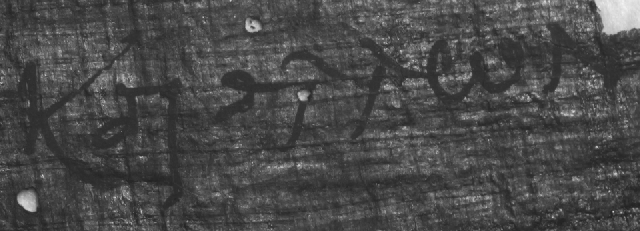 Figure 21.
Test sample photographed with Canon EOS DCS 3 digital camera.
Figure 21.
Test sample photographed with Canon EOS DCS 3 digital camera.
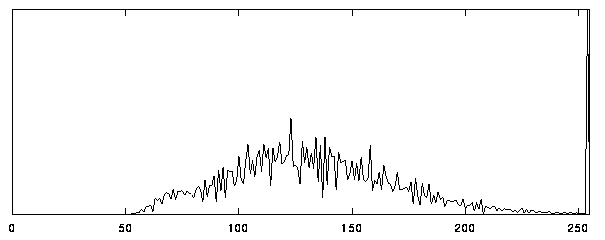 Figure 22:
Histogram of COHU 4710 CCD camera image (Fig.17)
Figure 22:
Histogram of COHU 4710 CCD camera image (Fig.17)
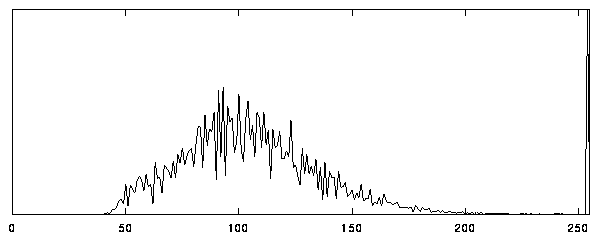 Figure 23:
Histogram of COHU 4710 CCD camera near-IR image (Fig.18).
Figure 23:
Histogram of COHU 4710 CCD camera near-IR image (Fig.18).
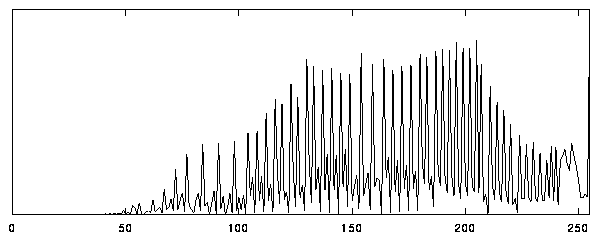 Figure 24:
Histogram of HP 3c flat scanner image (Fig.19).
Figure 24:
Histogram of HP 3c flat scanner image (Fig.19).
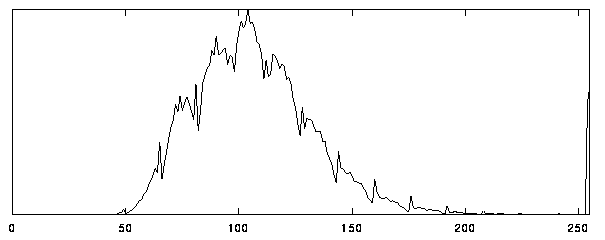 Figure 25.
Histogram of Umax1200S flat scanner image (Fig.20).
Figure 25.
Histogram of Umax1200S flat scanner image (Fig.20).
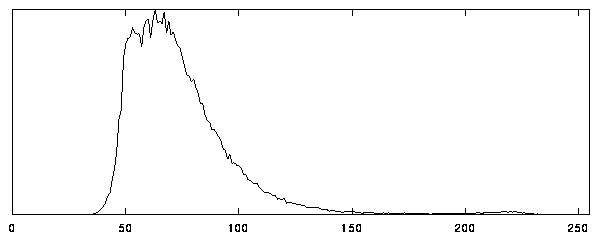 Figure 26.
Histogram of Canon EOS DCS 3 digital camera image (Fig.21).
A good choice for the measurement of goodness of a digitized
picture is the amount of information the image contains, or the
information density. Primarily, that depends on the spatial
resolution, and for dark objects such as carbonized papyri,
the sensitivity of the equipment's CCD elements (or simply
the number of grey scale values obtainable).
Typical maximum optical resolution of current flat scanners
is 600 dots per inch (dpi), and has been accepted as the
default resolution for many digital image archives such as
the Duke University Papyri Archive. For digital cameras
and CCD video cameras one cannot state a certain dpi-value,
because one can always use magnifying optics to digitize
a very small area with the equipment's maximum CCD matrix
size. In practice, one should be able to digitize at least
several words, or one whole papyri fragment, at a time.
A fragment of approximately 3.5x3.5 inches could be
digitized with a digital camera with 2048x2048 CCD matrix
to obtain the resolution of 600dpi. For practical purposes,
that would be enough.
The amount of different grey scale values as a second
basis for information density along with spatial resolution
is not simply defined. In principle, all the digital
image sources discussed here can provide all 255 different
grey scale values. For very dark objects the different
equipment produce very different results, as can be seen
in figures 22-26.
Setting a flat scanner for optimally recording a dark object
depends on the scanner's automatics and driver software. Many
scanners adjust the black and white levels automatically,
which leaves only little possibilities for optimizing the
results. Typically, the automatic adjustment produces
poor images. Also, usually the removed top casing contains
reference-black and reference-white stripes that the scanner
checks before every scan, and they must somehow be reproduced.
The scanners can be controlled by bundled software provided by
the manufactorer, or using standard TWAIN draivers (if the
scanner is TWAIN compliant) with common image processing
software. For some scanners, there is also software packages
expecially made for chosen image processing programs
that take full advantage of all the scanner's abilities
together with the features of the image processing program
(for example, the Umax PowerLook is shipped with Adobe
PhotoShop with "plug-in" software for acquiring images
from the scanner).
There are currently very economically
priced scanners offering 8, 10 or even 12 bits of depth.
Good results might be obtained with a 8 bit scanner, but the
more sensitive 3x10-bit CCD's provide better control over
shadow details and otherwise dark images.
Figure 26.
Histogram of Canon EOS DCS 3 digital camera image (Fig.21).
A good choice for the measurement of goodness of a digitized
picture is the amount of information the image contains, or the
information density. Primarily, that depends on the spatial
resolution, and for dark objects such as carbonized papyri,
the sensitivity of the equipment's CCD elements (or simply
the number of grey scale values obtainable).
Typical maximum optical resolution of current flat scanners
is 600 dots per inch (dpi), and has been accepted as the
default resolution for many digital image archives such as
the Duke University Papyri Archive. For digital cameras
and CCD video cameras one cannot state a certain dpi-value,
because one can always use magnifying optics to digitize
a very small area with the equipment's maximum CCD matrix
size. In practice, one should be able to digitize at least
several words, or one whole papyri fragment, at a time.
A fragment of approximately 3.5x3.5 inches could be
digitized with a digital camera with 2048x2048 CCD matrix
to obtain the resolution of 600dpi. For practical purposes,
that would be enough.
The amount of different grey scale values as a second
basis for information density along with spatial resolution
is not simply defined. In principle, all the digital
image sources discussed here can provide all 255 different
grey scale values. For very dark objects the different
equipment produce very different results, as can be seen
in figures 22-26.
Setting a flat scanner for optimally recording a dark object
depends on the scanner's automatics and driver software. Many
scanners adjust the black and white levels automatically,
which leaves only little possibilities for optimizing the
results. Typically, the automatic adjustment produces
poor images. Also, usually the removed top casing contains
reference-black and reference-white stripes that the scanner
checks before every scan, and they must somehow be reproduced.
The scanners can be controlled by bundled software provided by
the manufactorer, or using standard TWAIN draivers (if the
scanner is TWAIN compliant) with common image processing
software. For some scanners, there is also software packages
expecially made for chosen image processing programs
that take full advantage of all the scanner's abilities
together with the features of the image processing program
(for example, the Umax PowerLook is shipped with Adobe
PhotoShop with "plug-in" software for acquiring images
from the scanner).
There are currently very economically
priced scanners offering 8, 10 or even 12 bits of depth.
Good results might be obtained with a 8 bit scanner, but the
more sensitive 3x10-bit CCD's provide better control over
shadow details and otherwise dark images.
 Back to Scanning Photographs
Back to Scanning Photographs
 Back to Contents
Back to Contents
 Next: Miscellaneous Methods
Next: Miscellaneous Methods
Antti Nurminen, 34044T, andy@cs.hut.fi
 Figure 17:
Test image recorded by COHU 4710 CCD camera, enlargened from
462x150 pixels to 640x208.
Figure 17:
Test image recorded by COHU 4710 CCD camera, enlargened from
462x150 pixels to 640x208.
 Figure 18:
Test image recorded by COHU 4710 CCD camera in near-IR bandwidth (enlargened).
Figure 18:
Test image recorded by COHU 4710 CCD camera in near-IR bandwidth (enlargened).
 Figure 19:
Test sample scanned with HP 3c flat scanner.
Figure 19:
Test sample scanned with HP 3c flat scanner.
 Figure 20.
Test sample scanned with Umax1200S flat scanner.
Figure 20.
Test sample scanned with Umax1200S flat scanner.
 Figure 21.
Test sample photographed with Canon EOS DCS 3 digital camera.
Figure 21.
Test sample photographed with Canon EOS DCS 3 digital camera.
 Figure 22:
Histogram of COHU 4710 CCD camera image (Fig.17)
Figure 22:
Histogram of COHU 4710 CCD camera image (Fig.17)
 Figure 23:
Histogram of COHU 4710 CCD camera near-IR image (Fig.18).
Figure 23:
Histogram of COHU 4710 CCD camera near-IR image (Fig.18).
 Figure 24:
Histogram of HP 3c flat scanner image (Fig.19).
Figure 24:
Histogram of HP 3c flat scanner image (Fig.19).
 Figure 25.
Histogram of Umax1200S flat scanner image (Fig.20).
Figure 25.
Histogram of Umax1200S flat scanner image (Fig.20).
 Figure 26.
Histogram of Canon EOS DCS 3 digital camera image (Fig.21).
A good choice for the measurement of goodness of a digitized
picture is the amount of information the image contains, or the
information density. Primarily, that depends on the spatial
resolution, and for dark objects such as carbonized papyri,
the sensitivity of the equipment's CCD elements (or simply
the number of grey scale values obtainable).
Typical maximum optical resolution of current flat scanners
is 600 dots per inch (dpi), and has been accepted as the
default resolution for many digital image archives such as
the Duke University Papyri Archive. For digital cameras
and CCD video cameras one cannot state a certain dpi-value,
because one can always use magnifying optics to digitize
a very small area with the equipment's maximum CCD matrix
size. In practice, one should be able to digitize at least
several words, or one whole papyri fragment, at a time.
A fragment of approximately 3.5x3.5 inches could be
digitized with a digital camera with 2048x2048 CCD matrix
to obtain the resolution of 600dpi. For practical purposes,
that would be enough.
The amount of different grey scale values as a second
basis for information density along with spatial resolution
is not simply defined. In principle, all the digital
image sources discussed here can provide all 255 different
grey scale values. For very dark objects the different
equipment produce very different results, as can be seen
in figures 22-26.
Setting a flat scanner for optimally recording a dark object
depends on the scanner's automatics and driver software. Many
scanners adjust the black and white levels automatically,
which leaves only little possibilities for optimizing the
results. Typically, the automatic adjustment produces
poor images. Also, usually the removed top casing contains
reference-black and reference-white stripes that the scanner
checks before every scan, and they must somehow be reproduced.
The scanners can be controlled by bundled software provided by
the manufactorer, or using standard TWAIN draivers (if the
scanner is TWAIN compliant) with common image processing
software. For some scanners, there is also software packages
expecially made for chosen image processing programs
that take full advantage of all the scanner's abilities
together with the features of the image processing program
(for example, the Umax PowerLook is shipped with Adobe
PhotoShop with "plug-in" software for acquiring images
from the scanner).
There are currently very economically
priced scanners offering 8, 10 or even 12 bits of depth.
Good results might be obtained with a 8 bit scanner, but the
more sensitive 3x10-bit CCD's provide better control over
shadow details and otherwise dark images.
Figure 26.
Histogram of Canon EOS DCS 3 digital camera image (Fig.21).
A good choice for the measurement of goodness of a digitized
picture is the amount of information the image contains, or the
information density. Primarily, that depends on the spatial
resolution, and for dark objects such as carbonized papyri,
the sensitivity of the equipment's CCD elements (or simply
the number of grey scale values obtainable).
Typical maximum optical resolution of current flat scanners
is 600 dots per inch (dpi), and has been accepted as the
default resolution for many digital image archives such as
the Duke University Papyri Archive. For digital cameras
and CCD video cameras one cannot state a certain dpi-value,
because one can always use magnifying optics to digitize
a very small area with the equipment's maximum CCD matrix
size. In practice, one should be able to digitize at least
several words, or one whole papyri fragment, at a time.
A fragment of approximately 3.5x3.5 inches could be
digitized with a digital camera with 2048x2048 CCD matrix
to obtain the resolution of 600dpi. For practical purposes,
that would be enough.
The amount of different grey scale values as a second
basis for information density along with spatial resolution
is not simply defined. In principle, all the digital
image sources discussed here can provide all 255 different
grey scale values. For very dark objects the different
equipment produce very different results, as can be seen
in figures 22-26.
Setting a flat scanner for optimally recording a dark object
depends on the scanner's automatics and driver software. Many
scanners adjust the black and white levels automatically,
which leaves only little possibilities for optimizing the
results. Typically, the automatic adjustment produces
poor images. Also, usually the removed top casing contains
reference-black and reference-white stripes that the scanner
checks before every scan, and they must somehow be reproduced.
The scanners can be controlled by bundled software provided by
the manufactorer, or using standard TWAIN draivers (if the
scanner is TWAIN compliant) with common image processing
software. For some scanners, there is also software packages
expecially made for chosen image processing programs
that take full advantage of all the scanner's abilities
together with the features of the image processing program
(for example, the Umax PowerLook is shipped with Adobe
PhotoShop with "plug-in" software for acquiring images
from the scanner).
There are currently very economically
priced scanners offering 8, 10 or even 12 bits of depth.
Good results might be obtained with a 8 bit scanner, but the
more sensitive 3x10-bit CCD's provide better control over
shadow details and otherwise dark images.